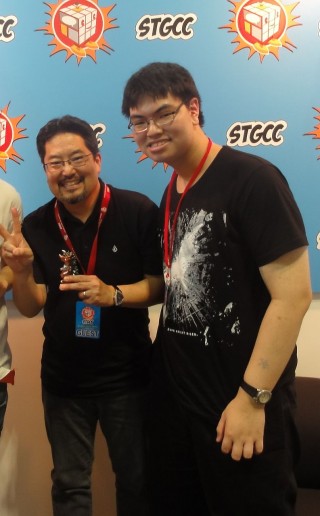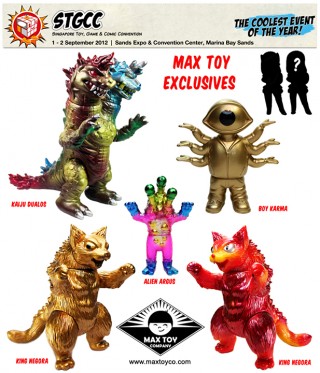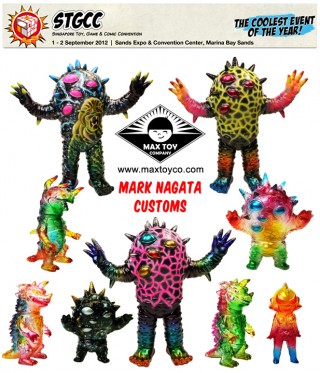For ActionFigurePics.com
STGCC 2012: Interview with Max Toy Co’s Mark Nagata – Part One
Jedd-the-Jedi had a chance to sit down with Mark at STGCC. In the first part of their conversation, they spanned toy collecting, the differences between working for the big guys vs. running your own show, and if it’s alright to play with your art toys. It’s really a fantastic interview. Read on!
Jedd: Hi Mark, great
to be talking to a fellow lover of toys. First off, what got you into
collecting toys? You wrote on your site “I think it’s safe to say that
most of us collect because of our childhoods,” so do you have any
childhood memories of a particular toy or action figure that you want to
share?
Mark Nagata: Oh boy, for sure.
Well I think the first impression I had for Japanese toys is when I was
about 9 years old, and I had an aunt who was living in Japan, and for
Christmas she sent a very big box to me, and inside were about 20
different Japanese toys. So Henshen cyborgs, Bullmark figures, kaiju
toys… but at the time, I didn’t know that’s what they were called. To
sort of back up a little, I’m third generation Japanese American, so my
parents were born in America and my grandparents came from Japan to
America, but me being third generation, actually I don’t understand
Japanese and I don’t speak Japanese, so when I got this box of toys, I
couldn’t read anything except for the company name Bullmark, ‘cause it
was printed in English. I didn’t know the names of the characters, I
didn’t know that they had TV shows; I just thought they were toys.
So, from that point, it was
really… I fell in love with the visual part of the toys. The way it
looked, the packaging, because all the packaging had like very dynamic
artwork and colours, very crazy colours, and all the kaiju for me… were
just… I couldn’t even put into words what it did to my imagination.
Because at that point, my toys in America were GI JOE 12 inch, Major
Matt Mason, so very… 60s, 70s types of toys, but um very plain, based on
like a real astronaut, or an army man. No imagination, right?
So when I opened that box, and I
saw these crazy colours, and these kaiju and these spacemen, I was like…
you know, what is this? I haven’t seen this before. So when I look back
all these years, that’s the point that started me on this journey to
this day, which is being able to make actual kaiju toys in Japan.
Do you feel that there’s a strict
dichotomy between Western and Asian popular culture, and to a certain
extent the toys? Because many Americans and Europeans have been
embracing manga and anime over the last two-three decades, and some
western artists have been influenced by it. As an illustrator, toy
collector, and toy designer, what do you feel is different or distinct
between Asian and Western toys and comics, to put them under those
umbrellas?
Wow, that’s a very hard question!
I guess my simple answer is, ah, for sure Asian culture has a much
longer history than America, than Western, and it’s much more diverse in
terms of its mythology. So, Western culture for the most part is based
on Christianity, but not ‘gods’ and ‘demons’ and… I mean, they have the
devil but, you know, it’s very much rooted in human types of characters,
whereas Asian cultures at least as far as I understand, you could have a
tree demon, you could have a water creature, it’s very much based on
nature. Wind, air, fire… so I think that’s also a reflection on kaiju
toys, is they’re much more free to create creatures that are not
confined by human structure, so it’s not just Frankenstein (‘s monster),
it can be an arm that has flame, a body that has ice and you know a leg
that’s metal and it all makes sense, it’s no problem. Whereas if you
try to that in America, (laughs), I think it really throws people off,
right? They don’t quite get it; it’s like “I don’t understand, why is
this arm like that.” But as you were saying, the influence of manga and
anime, now, the younger generation, they’re more acceptant of this type
of toy.
How different is it working for huge
toy companies such as Hasbro and Mattel, compared to working for
yourself at Max Toys? What did you glean from your experiences at the
two big toy giants?
Well, when I did work for Hasbro
and Mattel, I was a freelance illustrator; so basically, they would
contact me to do a specific job. So if it’s packaging, box art, or
backing cards for action figures, they would tell me exactly what to do.
Exactly what pose, it needs to be this colour, the arm has to go two
inches this way… so there is really not much freedom for myself to do
much with the job – basically, it’s a job. But at the time, I was not
designing toys, so it was strictly just artwork that I was doing for
them. You know, they’re big companies, so the bottom line for them is
they need to make money, and I understand that, you know. That’s just
the way it is with big companies. But in terms of my company now, I have
much more freedom to create whatever image I want… you know, paint the
artwork the way I want… it’s perfect, it’s perfect.
It seems that toy companies, like the
two I mentioned, are recognising the pull and power of adult collectors
more and more. So, should there be a big distinction between kids’
market toys and “adult collector” toys? There are some instances where
they cross over, but now there are less collector-aimed toys with action
features, where there once were. It seems to be that some kids actually
prefer highly-articulated figures, rather than those with five points
of articulation and giant guns stuck to their arms.
Sure, sure. Um, I think, maybe
about six or seven years ago, Hasbro and Mattel and a lot of the toy
companies, they started recognising art toys, or urban toys, as
something coming up, something that might be very popular. Designer
toys, all under the same category. But I think the flaw in their
execution was one of the appeals of these types of toys is you can
actually meet the maker, or you know the artist. So if it’s The Beast
Brothers and so on, it’s not a company, it’s two guys, right? And you
can actually go and meet them and they’re the creators. Whereas Hasbro
and Mattel, no matter what, they’re big companies, so you’re kind of
detached from becoming… having a personal involvement with them. So, I
know they try to move some of their toys in that direction, but um I
think really they will not be that successful, because collectors will
realise it’s not that honest. It’s the nature of the companies, and the
amount they have to make – they have to make a hundred thousand figures,
whereas a lot of us are making them in a couple of hundred pieces or
less, very limited.
Can toys be art, and is it then alright to play with art?
As far as I’m concerned, if you
buy one of my toys, you can do whatever you want with it! (Laughs). But I
think toys can be art, and you can still interact with it – it’s not a
problem.
What is your defense when people say
collecting toys is “childish?” – that if you collect toys, then that
automatically makes a silly, basement-dwelling man-child?
(Laughs) Wow! Those are very…
very strong words! As far I’m concerned, if you’re a very positive
person and you’re not harming anybody, then really, it should be
nobody’s business what you want to do. So, I try to be positive about
what I produce, but I don’t want to tell people that, you know, “don’t
open it,” you know, “keep it in the bag” or “keep it in a case”… it’s
really up to the person to just enjoy it how they want to enjoy it.
Collecting toys seems to be about the
passion. So how do you reconcile the “passion” part of the toys and
comics business with the “money-making” part? Because one doesn’t want
to be a starving artist but one doesn’t want to be a sell-out either.
Huge toy companies get a lot of flak for occasionally poor quality
control, reusing parts and molds, endless repaints and generally not
giving fans not what they want – so it does less of a problem in
smaller, more collector-oriented toy companies such as your own?
It’s… the one thing that is
similar with the bigger companies is that I do have to produce multiple
runs from the same mould. And that’s an economic decision, because I
have to invest a certain amount of money to have the toy made, and it
take me at least three runs to just break even. So by the time I get to
#4 or #5 or #6, then I can start making a little bit of a profit
(chuckles)… it’s really not that much. I mean, I think many collectors
would be surprised, um… I tell people “don’t go into the toy business if
you want to be rich”. (Laughs) It’s tough, it’s tough. And that’s why
the bigger companies have to make a hundred thousand or a million of
something, because that’s the only way they can make money.
Is it safe to assume that your interests in toys and in drawing went hand in hand?
Oh yes, for sure. And again, that
goes back to when I opened that box of toys from Japan, because the toy
was sitting right on top of a piece of artwork, you know, the
packaging. So as soon as I removed the toy, didn’t know which was better
right, the artwork or the toy!
Lots of kids draw pictures of their
action figures, and some artists use action figures as reference
material. Are you one of those artists?
Sometimes I do, yes. It’s cheaper than getting your friends to pose. (Laughs)
- Ron Mirasol
Thanks for reading guys and yes, do stay tuned! Hopefully, several mega-posts pertaining to my experience at STGCC are on their way. The cool cosplayers, fantastic displays, talented artist alley denizens...stay tuned for that too!



0 comments:
Post a Comment
Note: Only a member of this blog may post a comment.